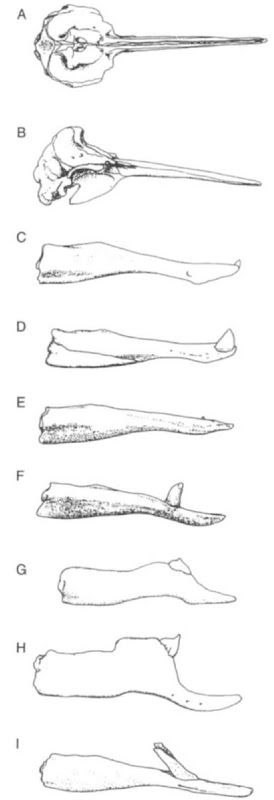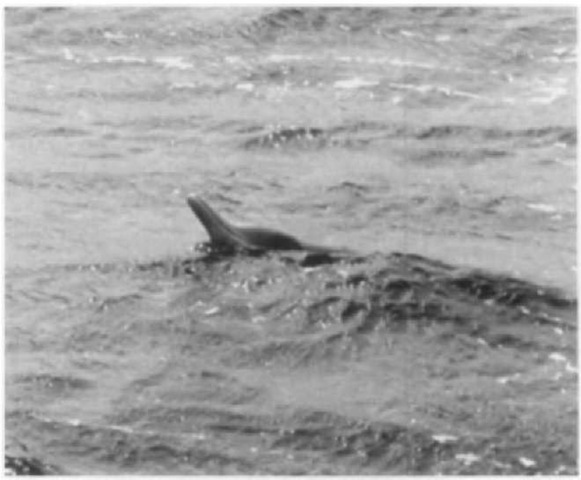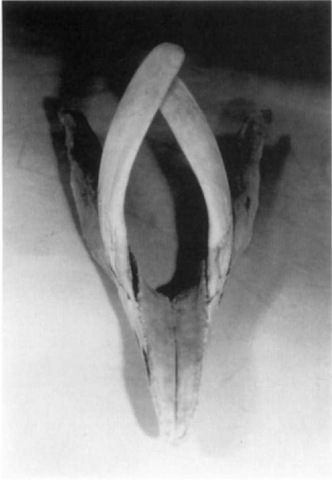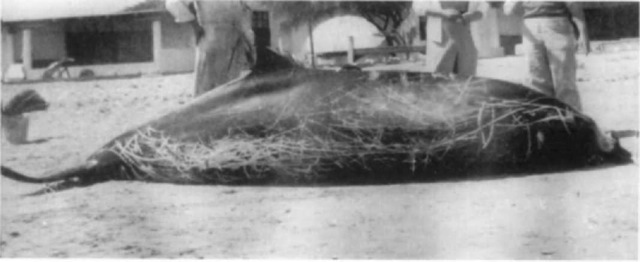The genus name Mesoplodon (Greek: mesos, middle: ho-pla, arms; odon, tooth: i.e., armed with a tooth in the middle of the jaw) was coined by Gervais in 1850. Ziphi-ids (beaked whales), including mesoplodonts, appeared suddenly in the fossil record in the lower Miocene (26 Mya), are well represented by the upper Miocene (5 Mya), and their diversity has declined steadily since then. Currently there are 13 recognized species in Mesoplodon (Table I), making it by far the largest cetacean genus, and it is likely that new species are yet to be discovered. In the eastern Pacific alone, two new species have been described (M. peruvianus in 1991 and M. bahamondi in 1995), and the description of a third is in preparation. Morphological and molecular genetic analyses confirm species limits within the group. Based on morphology, M. bowdoini and M. carlhubbsi have been suggested as possible subspecies, but genetic analyses indicate species level differences. Although there are no currently recognized subspecies, M. minis has (apparently) disjunct populations in the North Atlantic and the Southern Ocean that have markedly different color patterns, suggesting at least a subspecific level of divergence. Another ziphiid, Indopacetus pacifictis, up until very recently known only from two skulls, has often been included within Mesoplodon, but is now known to be generically distinct.
Historically, mesoplodont species have been diagnosed by features of the skull, relying mainly on the length of the rostrum, and the shape, size, and placement of teeth, especially of adult males (Fig. 1). However due to anatomical similarities (especially of females and young), specimens are often misiden-tified, even by experts, and molecular genetic analyses have recently become important for identifying individual specimens. Genetic techniques are also uncovering “cryptic” species. For example, geneticists recently reported a new species of mesoplodont that appears to be morphologically nearly indistinguishable from M. hectori.
I. Description
Mesoplodonts are small whales, ranging in size from 3.9 (M. peruvianas) to 6.2 (M. layardii) m; there are too few data to determine if there are consistent size differences between males and females, although in at least some cases, females appear to be slightly larger, as is the case for most ziphiids. The body is spindle shaped, with a small, usually triangular dorsal fin, located approximately two-thirds of the way back on the body. The flippers are small and narrow and fit into pigmented depressions in the body. The unnotched flukes are usually straight across the trailing edge or even slightly convex. A single pair of external throat grooves is present between the mandibles that apparently assists in suction feeding (see later). The head is small and tapered. The melon is small and blends without a crease into the beak. The blowhole is a half circle with the ends pointed forward and not always symmetric. Beak length is variable depending on the species, ranging from short (e.g.. M. densirostris) to very long (e.g.. M. grayi) (Fig. 2).
TABLE I Living Species of Mesoplodon”
|
Latin name |
English name(s) |
Length (m) |
Distribution |
|
M. hectori |
Hectors beaked whale: New Zealand beaked whale |
4.4 |
Circumglobal in temperate waters of Southern Hemisphere |
|
M. mirus |
Trues beaked whale |
5.3 |
Warm temperate North Atlantic and southern Indian Ocean |
|
M. europaeus |
Gervais’ beaked whale; Antillean beaked whale; Gulf Stream beaked whale |
5.2 |
Warm temperate and tropical waters of North Atlantic |
|
M. bidens |
Sowerby’s beaked whale; North Atlantic beaked whale; North Sea beaked whale |
5.5 |
Temperate North Atlantic from Europe to North America |
|
M. grayi |
Gray’s beaked whale; Haast’s beaked whale; scamper-down whale; small-toothed beaked whale |
5.6 |
Circumglobal in temperate waters of Southern Hemisphere |
|
M. peruvianus |
Pygmy beaked whale; Peruvian beaked whale; lesser beaked whale |
3.9 |
Eastern Pacific from northern Mexico to northern Chile |
|
M. bowdoini |
Andrew’s beaked whale; deep-crest beaked whale |
4.7 |
Known only from strandings in Australia and New Zealand |
|
M. bahamondi |
Bahamonde’s beaked whale |
? |
One specimen from Juan Fernandez Island, Chile |
|
M. carlhubbsi |
Hubbs’ beaked whale; arch-beaked whale |
5.3 |
Temperate north Pacific from California to Japan |
|
M. ginkgodens |
Ginkgo-toothed whale; Japanese beaked whale |
4.9 |
Tropical and warm temperate waters of the Indian and Pacific oceans |
|
M. stejnegeri |
Stejneger’s beaked whale; Bering Sea beaked whale-, saber-toothed whale |
5.2 |
Sub-Arctic and temperate north Pacific trom California to Japan |
|
M. layardii |
Layard’s beaked whale; strap-toothed whale; long-toothed beaked whale |
6.2 |
Circumglobal in temperate and sub-Antarctic southern waters |
|
M. densirostris |
Blainville’s beaked whale; dense beaked whale |
4.7 |
Circumglobal in tropical and warm temperate waters |
“Lengths are maxima.
Figure 1 Selected Mesoplodon skulls and mandibles. (A) Dorsal view of M. grayi skull. (B) Lateral view of M. grayi skull. Lower jaws of (C) M. mirus, (D) M. hectori. (E) M. eu-ropaeus, (F) M. stejnegeri, (G) M. ginkgodens, (H) M. den-sirostris, and (I) M. layardiioitw are all of adult males except E.
Most species show three sexually dimorphic traits, all of which relate to male aggressive behavior at the onset of sexual maturity: (1) only adult males have functional teeth, (2) only adult males have extensive secondary ossification of the mesorostral canal, and (3) only adult males show extensive and conspicuous body scarring. These features are discussed later.
Males apparently use their teeth for intraspecific fighting with other males to establish breeding hierarchies. In fully mature males, a single pair of teeth erupts from the mandibles and projects up. outside of the mouth, along both sides of the rostrum. Depending on the species, the teeth are located anywhere from the tip of the lower jaw (apical) to about halfway back along the jaw, and they vary markedly in size and shape (Fig. 1). In most species, the teeth are laterally compressed, although in M. mirus, which has the most apical teeth, they are oval in cross section. The tooth usually has a sharp denticle on top for inflicting wounds, but this can be worn down smooth in older males. In some species, the tooth is raised up on a high bony arch in the lower jaw (e.g., M. densirostris): in other species, the mandible is relatively flat and teeth of varying length are surrounded and supported mainly by gum tissue.
A hypothesis of evolutionary trend for mesoplodonts proposes that the occurrence of apical teeth is a primitive condition and more posterior locations are derived. Teeth positioned further back on the mandible apparently allow animals to attack more forcefully with their rostrum with less risk of damage to the mandibles or teeth. However, teeth further back along the lower jaw need to be elevated or elongated so that they are not obstructed by the rostrum, which gets wider and deeper toward the base. These factors have probably contributed to the marked variation in tooth size and placement within this group (Fig. 1). As an extreme example, M. layardii has some of the most bizarre teeth of any known animal. They are long (to at least 34 cm) and curl back over the rostrum so that they sometimes overlap each other, clamping the jaws nearly shut (Fig. 3). These teeth have dorsally projecting denticles and, judging by the amount of scarring on adult males, are still effective for intraspecific fighting. However, in many individuals, tooth wear results from the rostrum rubbing against the inner sides of the teeth. This clearly indicates that jaw movement is impaired, and the adaptive significance of tooth shape in this species has never been adequately explained.
Figure 2 Gray’s beaked whale is unusual among the Mesoplodon species in having a long beak like a dolphin.
The mesorostral canal is a narrow groove in the midline of the upper rostrum that is filled with cartilage in most cetaceans. This cartilage is continuous with the mesethmoid and homologous to the nasal septum of terrestrial mammals. In adult male mesoplodonts, the cartilage is displaced by expansion of the vomer from below, which is composed of extremely dense bone, in some cases more dense than elephant ivory. When males attack, they make contact with the top of their rostrum and use their teeth with the mouth in the closed position. It has generally been assumed that the heavily reinforced rostrum was selected to allow fighting males to be more forceful with their attacks while reducing the possibility of damage to the rostrum. A recent study, however, suggested that the bone of the rostrum, although very dense, was too brittle to provide mechanical reinforcement and that it might, for example, have a hydrostatic role to assist in deep diving.
Figure 3 Lower jaw of an adult male Mesoplodon layardii showing how the teeth wrapped around the upper jaw in the living animal.
Color patterning among mesoplodonts is poorly known because animals at sea are sighted so infrequently and the few fresh animals that do strand on beaches lose their colors quickly. Most species are so similar, especially females and juveniles, that even on the rare occasion when animals are clearly seen at sea, few can be identified. This applies to stranded animals as well. Live animals are usually a nondescript gray or brown dor-sally and somewhat paler ventrally. Most have no distinguishable overall pattern, although some are quite distinctively marked. For example, M. mirus (Southern Hemisphere form) has an all white tail stock, dorsal fin, and flukes; M. layardii has a very distinctive black and white pattern to the head, face, and beak, and adult males of an unidentified mesoplodont from the eastern tropical Pacific (probably M. pemvianus) have a broad white swathe across the body that forms a conspicuous chevron when viewed from above.
Most mesoplodonts exhibit sexually dimorphic coloration, with adult males patterned more conspicuously than females. This can be due either to pigment deposition (e.g., M. carl-hubbsi) or, more often, to adventitious coloration from scarring. Most scars on mesoplodonts are attributable to tooth rake injuries from other males or wounds from cookie-cutter shark bites (see later). All mesoplodonts, except apparently M. ginkgo-dens, form white scar tissue over external wounds so that the body retains a permanent visual record of any injuries. As a result, adult males in groups of mesoplodonts are usually easily recognizable by their prominent scarring (Fig. 4), and it has been suggested that this may have evolved as a social signal for indicating male “quality.” In addition to heavy scarring, adult males (and, to a lesser extent, females) of some species have white pigment patches that may serve to highlight important anatomical landmarks, including the beak tip, head, lips, and genital area.
II. Distribution and Zoogeography
Mesoplodonts are so difficult to approach and identify under normal conditions that there are several species that have never been identified alive in the wild (e.g., M. botvdoini, M. hectori, M. bahamondi, M. europaeus, M. ginkgodens). Consequently, nearly everything known about their distribution and abundance has been inferred from relatively infrequent stranding events. As a group they are widespread, occurring in all of the worlds oceans except for the coldest waters of the Arctic and Antarctica. They normally inhabit deep ocean waters (>2000 m) or continental slopes (200-2000 m), and only rarely stray over the continental shelf. The distribution of most species tends to be somewhat localized (limited to single ocean basins; Table I), although M. densirostris is found in all tropical and warm temperate oceans and is perhaps the most widespread mesoplodont. Seasonality of stranding records suggests that at least some high-latitude species (e.g., M. layardii) may undergo some limited migration to lower latitudes during the local winter.
Figure 4 A stranded specimen of an adult male Mesoplodon (probably M. peruvianus) from Para-cas, Peru. Note white scarring over most of the body from fighting with other males.
III. Food and Feeding
Based on stomach contents of stranded animals, mesoplodonts feed primarily on mesopelagic squid (e.g., Histio-teuthis spp., Taonis spp., Gonatus spp.), although some mesopelagic fish may also be taken (at least some of these fish, however, are probably secondary, i.e., squid, prey). Most prey are probably caught at depths of 200 m or more. A reduced dentition among various species of odontocetes (toothed cetaceans) is generally interpreted as an adaption for feeding on squid. Most squid-feeding cetaceans, including meso-plodonts, are thought to be suction feeders: prey is sucked in and swallowed whole. Large muscles at the back of the tongue (hyoglossus and styloglossus) are anchored to an enlarged hy-oid bone; this allows the tongue to be retracted in a piston-like manner while the throat pleats allow distention of the mouth floor, creating the necessary vacuum for sucking in prey. Because ziphiids in general no longer need their teeth for feeding this has freed them up to evolve for other purposes, i.e., as fighting weapons. It has been hypothesized that white pigmentation on the anterior floor of the mouth of many beaked whale species may serve as an attractant for bioluminescent squid.
IV. Behavior
Almost nothing is known about mesoplodont behavior, partly because they are so rarely sighted, but also because their behavioral repertoire at the surface appears to be veiy limited and stereotyped. The most commonly reported behavior has been slow swimming, usually away from a vessel, and often a mile or more away. When undisturbed, they roll quietly several times at the surface and then dive from 20 to over 45 min at a time. Most groups surface simultaneously and within a few body lengths of each other, indicating that some communication is probably going on as they forage in total darkness of the deep ocean. While at the surface, either traveling or stationary, individuals in groups usually remain within a couple body lengths of each other. Breaching (leaping out of the water) has been recorded on only a very few occasions. Long-beaked forms (e.g., M. grayi, M. bkiens, and M. layardii) often bring their beak up out of the water at a 45° angle when they surface. Normally there is no visible blow, and none are known to lift their flukes when diving. Tail slapping has been reported once. Male mesoplodonts are assumed to use their erupted teeth as tusks to fight with each other, and although none of these battles have ever even reported by human observers, the extensive scarring found among males of this group suggests that it is of frequent occurrence (Fig. 4).
V. Other Life History Notes
Because of their shy nature, far offshore habitat, and apparent rarity, veiy little is known about the biology of mesoplodonts, and nearly everything that is known has come from the examination of stranded animals. As in all cetaceans, females give birth to a single calf. Mean body length for calves at biith has ranged from 2,1 m for M. europaetis to 2.5 m for M. carlhubbsi, representing from 40 to 48% of the adult female body lengths (these are neither the largest nor the smallest mesoplodonts). The smallest mesoplodont calf reported to date is 1.9 m (M. hectori), although M. peruvianus will probably prove to be smaller. There is no information on gestation or lactation periods.
Longevity data for mesoplodonts are virtually nonexistent, although they may be quite long lived: a count of tooth layers in a specimen of M. europaeus suggests that it was at least 27 years old. A female M. densirostris estimated to be 9 years old (based on tooth layer counts) had just recently become sexually mature. Very little has been recorded in the way of diseases, parasites, or commensals. Osteomyelitis has been reported twice. Endoparasites recorded have included cestodes and occasional heavy infestations of nematodes (Crassicanda sp.) in the kidneys. Ectoparasites recorded include Penella sp. (a parasitic copepod) and cyamids. The erupted teeth of males often have stalked barnacles (Conchodenna sp.) attached to them; bunches of these often appear as “tassels” on the teeth of live animals at sea. A pseudo-stalked barnacle. Xenobalanus sp,, is sometimes attached to the flukes and dorsal fins. Almost nothing is known about mesoplodont vocalizations. Stranded animals on beaches have been reported to make cow-like sounds but there are no known recordings of vocalizations at sea. Because they almost certainlv use sounds to coordinate deep diving behavior among herd members and locate prey in total darkness, it is likely that they do vocalize.
Mesoplodonts occur in small groups typically ranging in size from 1 to 6 animals, although groups of up to 10 have been reported, and a mass stranding of 28 M. grayi occurred in New Zealand. Mean school size for 125 Mesoplodon sightings (including at least three different species) from the eastern tropical Pacific was 3.0, with 2 being the most common group size. Although mixed groups of adult males with females and calves have been observed at sea, there is some evidence from both sightings and strandings data that there may be some segregation by sex or age class at times. Predators of mesoplodonts probably include killer whales and large sharks, although direct observations are lacking. Mesoplodonts often have white oval scars (diameter to about 8 cm) caused by the bites of cookie-cutter sharks (Isistius sp.). These are small (to about 50 cm), mesopelagic sharks that feed by snatching mouthfuls of flesh off larger fish and cetaceans. Although individual mesoplodonts are often riddled with scores of healed bite wounds, these do not appear to contribute to mortality.
VI. Status and Conservation
So few mesoplodonts have been reliably identified at sea that it is impossible to accurately determine the population status of any species, although based on stranding data, at least some species may not be as rare as the sighting records indicate. M. grat/i and M. layardii appear to be widespread and fairly common in the Southern Ocean, as is M. densirostris in tropical oceans. These may be the most abundant mesoplodonts. Most species, however, appear to be neither numerous nor widespread, and some may be quite rare (e.g., M. bow-doini, M. hectori). The large number of species in this group suggests a high rate of endemism with naturally small populations and restricted ranges. Although there has never been any directed fishery for mesoplodonts. a few are occasionally harpooned opportunistically by whalers, and unknown, but potentially significant, numbers are killed by high seas drift nets and long line fishing gear. Only stranded specimens have ever been kept in captivity and these have usually died within a few days (usually from preexisting conditions).




